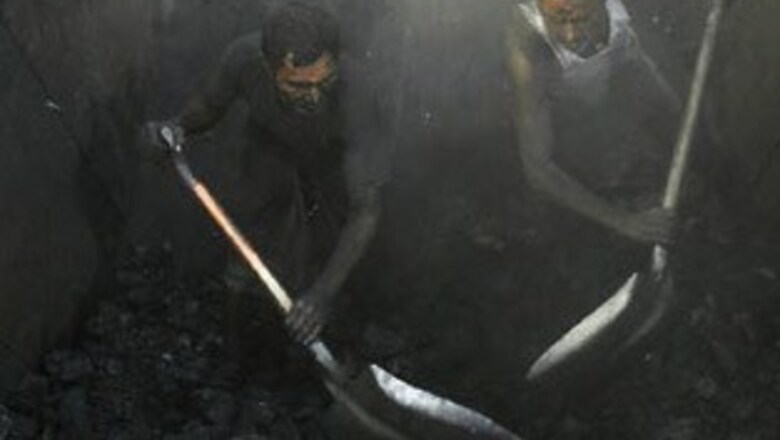
views
Korba: A thin coat of coal dust covers everything from trees to houses in Korba, a coal mining town which lies at the heart of the India's struggle to balance economic growth with climate change concerns.
The air is heavy with smoke and dust spewing out of numerous mines and power plants in a region that powers hundreds of factories in the country's industrial west and lights up millions of homes.
Although government has announced a new climate plan which identifies renewable energy such as solar power as key elements, coal remains the backbone of energy supply in a country where almost half the 1.1 billion population still has no electricity.
"Coal-fired power will stay for the next 20-25 years at least," said R D Sonkar, chief engineer at one of Korba's many thermal power stations.
"Look at the high cost of solar and wind energy. Can we afford? Power from renewable energy will have to wait, I think."
As the world meets in Copenhagen for crucial negotiations on a global pact to fight climate change, part of the debate will be on how developing countries such as India tackle the use of fossil fuel without hampering their growth.
India, the world's fourth largest greenhouse gas emitter though still low on per-capita emissions, is under pressure to cut pollution to battle climate change while demand for power increases as its middle class clamours for more cars, TVs and housing.
The government set a goal on Thursday for slowing the growth of greenhouse gas emissions, saying it was willing to rein in "carbon intensity"--the amount of carbon dioxide (CO2) emitted per unit of economic output -- by between 20 and 25 percent by 2020, from 2005 levels.
The big emerging economies have often insisted that rich nations have caused global warming by spewing out greenhouse gases since the Industrial Revolution, and want to see deep cuts by these rich nations before joining the effort.
Current global pacts do not require developing nations to cut emissions, but rich countries are obliged to do so.
The December 7-18 UN talks in the Danish capital are aimed at settling a legally binding deal after arguments between rich and poor nations about who should cut emissions, by how much and who should pay.
As the world discusses the implications of climate change and plans to cut emissions, experts say it is coal towns such as Korba that will shape the country's efforts to eradicate poverty.
"There is a lot of focus on clean coal and super critical technology to increase efficiency, but coal will remain central," said Sunita Narain, member of the Prime Minister's council on climate change.
"There are two aspects -- affordability of coal in a country where there is a lot of poverty and largescale generation that is required to reach power to a huge portion of the population."
Coal is seen as the solution to the country's power shortage, a daunting barrier to development where massive rural poverty means people cannot afford costly electricity produced from renewable sources.
Last year, the country faced a 16.6 percent shortfall during hours of peak consumption and a 9.9 percent gap for energy generation, World Bank figures show.
The country has 10 percent of the world's coal reserves, the biggest after the United States, Russia and China, but it also imported about 70 million tonnes of high grade coal this fiscal year, mostly for making steel.
The country plans to add 78.7 gigawatts of power generation during the five years ending March 2012, most of it from coal, which now accounts for about 60 percent of India's energy mix.
Renewables
In comparison, renewables such as wind, solar and bio-mass contribute only 8.8 percent to generation and, though there are plans to scale up solar power generation to 20 gigawatts by 2022, it depends on international finance and technology.
A landmark nuclear deal with the United States may herald a new chapter in clean energy in the country, but long gestation periods for nuclear reactors and high cost are a deterrent.
Even if the country is on track with its renewable energy plans, coal will still account for about 55 percent of its power supply by 2030, according to government figures.
"Clearly, it's not a question of choice for India. Coal will remain at the core but what will change is there will be more thrust on clean coal technology," said Ashok Sharma, climate change expert at Halcrow Consulting India.
The government issued a national climate change policy last year, identifying renewable energy like solar power, and energy efficiency as key elements.
Already, its carbon and energy use per unit of GDP are both below that of the United States and China. And India had only about 12 vehicles per 1,000 people in 2007 compared to over 800 in the United States.
India's industrial electricity tariffs are, on average, the highest in the world, a measure aimed at deterring wastage.
"India's focus is a combination of improved coal, enhanced efficiency, some use of gas, solar and wind power ... eventually it's about positioning yourself for the future technology," said Nitin Desai, one of the architects of India's climate policy.
"You can't immediately say I won't use coal -- you have to look at the balance of energy security."




















Comments
0 comment